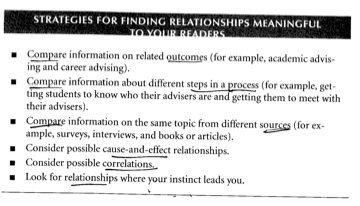Today we are primarily focused on workshopping your memos, which we’ll do in stages.
First, you’ll first spend 5 minutes individually reading Group 1’s memo and data. Next, you’ll spend 5 more minutes sharing your thoughts in small groups and commenting on the memo. We’ll then reconvene as a large group for 5 more minutes to debrief. We’ll repeat this process with Group 2 and so on. Because I uploaded each memo to Google Docs, you should be able to make comments and edits right in the doc, which everyone can see. I’ll show you how to use these features before we start. Here are the memos and data:
Group 1 –social media in the workplace: [memo] [data]
Group 2 –cloud-based options: [memo] [data]
Group 3 –video conferencing: [memo] [data]
Group 4 –online collaboration sites/software: [memo] [data]
Group 5 –web design: [memo] [data]
As you read these, consider the following process:
- First, individually read the data a few times. Then, ask yourself: what does the data say? What does it not say? That is, what can it not tell me?
- Then, read through the memo. What does the group focus on? Was is the same points you saw? Different? In other words, how did the group interpret this data? Do you agree with it? Are there are there alternative explanations for the data? Does the data ever make interpretation difficult? Discuss these questions in your small groups.
- Finally, think about how you might actually use this data as someone who will be graded on making a case for a certain kind of tech briefing. Would this memo be helpful in making that case? Let this question guide many of your comments.

